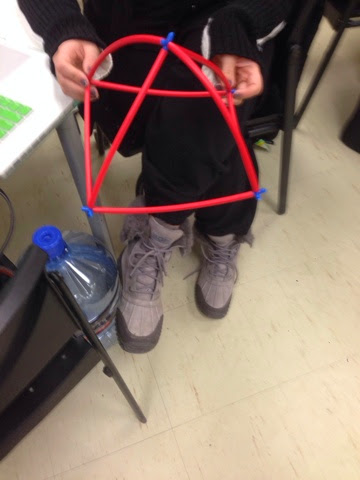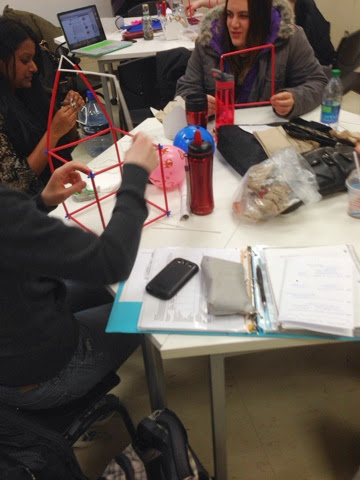Geometry and Spatial Sense
BCD Students, Natasha Nitsopoulos and Sarah Brennan, Constructivist Teaching
Experience in Our Classroom
Natasha and Sarah's Trip to the Store!!
Initial Engagement
Exploration
Investigation
Communication
"Messing About in our class"
K - What you know?
W- What you want to know?
H- What is your hypothesis?
L - What did you learn?
K - What you know?
W- What you want to know?
H- What is your hypothesis?
L - What did you learn?
Reflection
-
Explain your teacher research focus. What are you trying to understand about your work with young children as it relates to the learning area of math?
Geometry and Spatial Sense is everywhere around us! Math is incorporated into our everyday lives and through this activity, the children can explore the shapes and further expand their own knowledge. Children may be able to connect their previous knowledge and make connections that demonstrate their understanding.
Provide background information about the children and the early learning setting (as shared in the blog).The teacher in this blog first used a PowerPoint that fully described that shapes are everywhere. In the presentation, it showed examples of pictures and the children were to describe what shapes they saw. The children seemed to have a good understanding on shapes and were ready to explore the shapes in more depth.
Describe your process for collecting and understanding the data.We found the easiest ways to collect and understand our data was through Pinterest. We were able to work together and research through pictures, blogs and other sources. We pinned pictures and were always able to go back and refer to our research. The resources gave us ideas and inspired us to create a board based on Geometry and Spatial Sense.Reflect on what you found and what you learned.We learned that children know about shapes and that shapes are all around us. We continued to look around our work environment and find shapes. We then commented that we never explore the settings. We found it interesting that most teachers used worksheets and cut-outs to give to the children, in order to teach Geometry and Spatial Sense.
Make recommendations for other teacher researchers. Discuss what it was like to do your project and how others in the field can apply your findingsThe project was fun and taught us a lot about math in our everyday life. Teachers should refer to Pinterest and other social media sites to learn about activities and understand the difference between being a constructivist teacher and a traditional teacher. Children learn best through using the constructivist approach and educators need to know about their students and view them as being fully capable. We applied our overall findings through a blog because we felt it helped to organize our research and it was easy to navigate. Educators should get out of their comfort zone and use different types of methods to teach their students.
Mathematical Processes
Problem Solving
After experimenting with a shape that doesn't roll, they will investigate the problem and collaborate with others which shape does roll.
Reasoning and Proving
Asking the children, "What do you think will happen once you use the square?" They may be able to recognize that shapes with a flat surface slide, rather than roll.
Reflecting
Teachers will model the reflection by asking questions such as, "What would happen if you use a different side of that shape?" This will clarify their understanding and explain if they have solved the problem.
Selecting Tools and Strategies
The cylinder will be an interesting shape to observe if the child notices that it rolls and slides. This will determine the understanding of the purpose.
Connecting
Math is everywhere around us! From this activity, children may build and make the representation of structures around our everyday lives. If a child describes the playground setting, they will be able to make the connection that the playground has many shapes as well.
http://www.pinterest.com/pin/569212840375489616/
Representing
Children may make a Venn Diagram, shown in the picture below, where they can see their representation ideas.
http://www.pinterest.com/pin/569212840375495462/
Communication
Once this activity is complete, the children may communicate their understanding and express their knowledge through dramatization. Children may work in teams to build shapes using their bodies.
http://www.pinterest.com/pin/569212840375489519/
After experimenting with a shape that doesn't roll, they will investigate the problem and collaborate with others which shape does roll.
Reasoning and Proving
Asking the children, "What do you think will happen once you use the square?" They may be able to recognize that shapes with a flat surface slide, rather than roll.
Reflecting
Teachers will model the reflection by asking questions such as, "What would happen if you use a different side of that shape?" This will clarify their understanding and explain if they have solved the problem.
Selecting Tools and Strategies
The cylinder will be an interesting shape to observe if the child notices that it rolls and slides. This will determine the understanding of the purpose.
Connecting
Math is everywhere around us! From this activity, children may build and make the representation of structures around our everyday lives. If a child describes the playground setting, they will be able to make the connection that the playground has many shapes as well.
http://www.pinterest.com/pin/569212840375489616/
Representing
Children may make a Venn Diagram, shown in the picture below, where they can see their representation ideas.
http://www.pinterest.com/pin/569212840375495462/
Communication
Once this activity is complete, the children may communicate their understanding and express their knowledge through dramatization. Children may work in teams to build shapes using their bodies.
http://www.pinterest.com/pin/569212840375489519/
Observation
Lastly, the children were to show their observations. This was done in two separate ways; one was a chart and the other was through hula hoops that separated the categories. Here are the pictures that demonstrate the overall observation.
http://www.pinterest.com/pin/569212840375494598/
http://www.pinterest.com/pin/569212840375494598/
http://www.pinterest.com/pin/569212840375495462/
The other observation is,
The children would then make the observation that if a shape has sides, it will slide down the surface but if the shape is round, it will roll. Some shapes can roll and slide and further discussion can be incorporated.
Making Connections
After exploring the shapes, it is important to allow the children to experiment. Sarah and I would then bring in materials to have the children explore and, "get messy." The children in another inspiring blog, explored the shapes in a fun, creative and interesting way. The children were given a flat surface and many shapes. The children were exploring these materials and started placing shapes on the surface to see what came next. She began by encouraging the children to make predictions and explain their thinking before letting their shapes go down the flat surface. They are encouraged to explore all of the sides and determine if the shapes roll, slide or stack.
The children may demonstrate their learning by saying, doing and representing. The children may say, "I think the circle will roll down the ramp." This is a representation of oral communication that describes their thinking and possible resigning (FDELK, 2011). This is an interactive experiment and involves engagement, observation, experimentation and social interaction (FDELK, 2011). This activity invites children to play with the shapes and surface and inquire meaning through their learning. They will then represent their learning. They may do this step by forming questions as to why some of the shapes slide and why others roll (FDELK, 2011).
It is the responsibility for the Team's Intentional Interaction to combine the understanding and interaction to help the children's development (FDELK, 2011). They may do this by responding, challenging and extending the learning for the children (FDELK, 2011). From the first experiment with yarn, the teacher then responds to their interests and implement a program that is thoughtfully planned. One way the team may do this is to say, "I notice that you...(FDELK,2011)." For further steps, challenging the the development of all children in the class. This will determine how the team uses the information and scaffolds the learning (FDELK, 2011). The team in this example was able to make learning interesting by using ramps to describe shapes. They will then ask critical questions such as, "How did you figure that out?" The last step is extending. This is where the children can draw from their understanding, dramatize being shapes and more (FDELK, 2011).
Here is the activity!
http://www.kindergartenkindergarten.com/shapes/
The children may demonstrate their learning by saying, doing and representing. The children may say, "I think the circle will roll down the ramp." This is a representation of oral communication that describes their thinking and possible resigning (FDELK, 2011). This is an interactive experiment and involves engagement, observation, experimentation and social interaction (FDELK, 2011). This activity invites children to play with the shapes and surface and inquire meaning through their learning. They will then represent their learning. They may do this step by forming questions as to why some of the shapes slide and why others roll (FDELK, 2011).
It is the responsibility for the Team's Intentional Interaction to combine the understanding and interaction to help the children's development (FDELK, 2011). They may do this by responding, challenging and extending the learning for the children (FDELK, 2011). From the first experiment with yarn, the teacher then responds to their interests and implement a program that is thoughtfully planned. One way the team may do this is to say, "I notice that you...(FDELK,2011)." For further steps, challenging the the development of all children in the class. This will determine how the team uses the information and scaffolds the learning (FDELK, 2011). The team in this example was able to make learning interesting by using ramps to describe shapes. They will then ask critical questions such as, "How did you figure that out?" The last step is extending. This is where the children can draw from their understanding, dramatize being shapes and more (FDELK, 2011).
Here is the activity!
http://www.kindergartenkindergarten.com/shapes/
This area of mathematics can also relate to Data Management. The children are sorting, classifying and comparing the objects to describe the attributes (FDELK, 2011, DM5.1).
They may also respond and pose questions about the data collection and work together to make a graph (FDELK, 2011, DM5.3).
Our Inspiration
After receiving the topic Geometry and Spatial Sense, we explored the internet to find ways to introduce the topic. We were surprised to see that many blogs were using cut-outs, worksheets and more. We continued our research and came to three blogs that inspired us the most. We really enjoyed the way that a teacher introduced Geometry to her class. The teacher started the topic off with a PowerPoint to the class. She used this to warm the class up and give them knowledge about shapes. Below is the PowerPoint.
http://www.kindergartenkindergarten.com/shapes/
This PowerPoint really allows the children to recognize real objects as well as allowing them to begin learning about shapes that are in our everyday lives.
Another educator used a different approach that involved the children to be active. She used yarn and the children were to catch the yarn and pass it to their friends. They then explored the web that they created and found multiple shapes within the web. The children were so excited about it! Here is a picture and the link
http://www.pinterest.com/pin/569212840375494462/
http://www.kindergartenkindergarten.com/shapes/
This PowerPoint really allows the children to recognize real objects as well as allowing them to begin learning about shapes that are in our everyday lives.
Another educator used a different approach that involved the children to be active. She used yarn and the children were to catch the yarn and pass it to their friends. They then explored the web that they created and found multiple shapes within the web. The children were so excited about it! Here is a picture and the link
http://www.pinterest.com/pin/569212840375494462/
Subscribe to:
Comments (Atom)



























